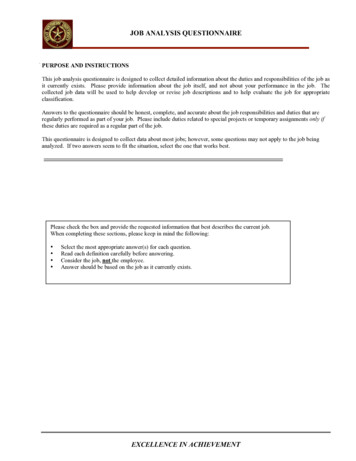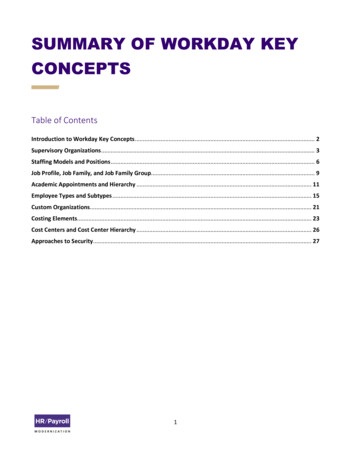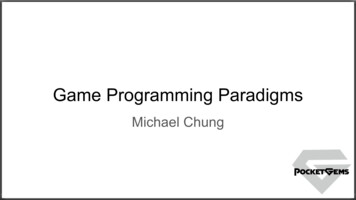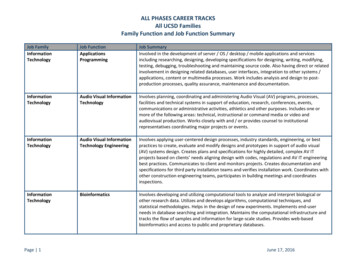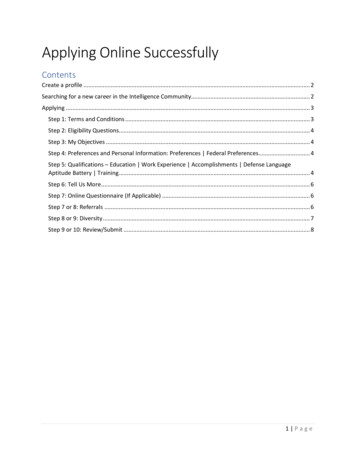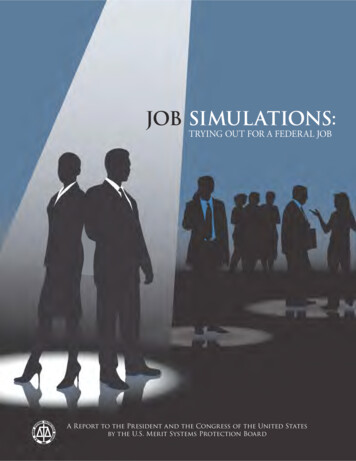
Transcription
JOB SIMULATIONS:TRYING OUT FOR A FEDERAL JOBA Report to the President and the Congress of the United Statesby the U.S. Merit Systems Protection Board
THE CHAIRMANU.S. MERIT SYSTEMS PROTECTION BOARD1615 M Street, NWWashington, DC 20419-0001September 2009T he PresidentPresident of the SenateSpeaker of the House of RepresentativesDear Sirs and Madam:In accordance with the requirements of 5 U.S.C. 1204(a)(3), it is my honor to submit this Merit SystemsProtection Board (MSPB) report, Job Simulations: Trying Out for a Federal Job. The purpose of this report is toexamine the utility of job simulation assessments for use in the Federal hiring process.We define job simulation as an assessment that presents applicants with realistic, job-related situationsand documents their behaviors or responses to help determine their qualifications for the job. Job simulationassessments can be a critical measure in ensuring that agencies are selecting the best candidates. Simulationscan do a better job of predicting which applicants will perform well on the job than many other commonly usedassessments, and they can provide a greater degree of fairness in the process. However, their potentially highdevelopment cost is a key drawback.Job simulations may not work in every situation. It is important, therefore, for agencies to have a goodgrasp of the job for which they are hiring, the competencies needed for that job, and knowledge about whichassessments would best fit their specific needs. This report identifies a number of factors for agencies to considerwhen making decisions about their assessment process. Also, it identifies a 5-step assessment strategy we believeshould help agencies develop and implement an assessment program that assists them in selecting employees onthe basis of relative ability, knowledge, and skills, as set forth in the merit system principles.I believe that you will find this report useful as you consider issues affecting the Federal Government’s abilityto assess and select a high-quality workforce now and in the future.Respectfully,Neil A. G. McPhie
JOB SIMULATIONS:TRYING OUT FOR A FEDER AL JOBA Report to the President and the Congress of the United Statesby the U.S. Merit Systems Protection Board
U.S. Merit Systems Protection BoardNeil A. G. McPhie, ChairmanMary M. Rose, Vice ChairmanOffice of Policy and EvaluationDirectorJohn Crum, Ph.D.Project ManagerLaura Shugrue
Executive SummaryTable of ContentsExecutive Summary . iIntroduction . 1Background . . 1Purpose and Methodology . . 2Principles Of Assessment . 5Benefits of Good Assessments . . 5What Makes a Good Assessment? . 6Job Simulations: What They Are . 9Definition . 9Overview of Advantages and Disadvantages . 10Types of Job Simulations . 12Job Simulations: How Federal Agencies Use Them . 17Nature of Assessment Programs . . 17Use of Job Simulation Assessments . 20Formulating An Assessment Strategy . 25(1) Conduct a Job Analysis . . 26(2) Identify the Assessments . 28(3) Develop Testing Procedures . 34(4) Select Qualified Assessors . . 35(5) Measure the Success of the Assessment Procedures . . 37Conclusion . 38Appendix A— Types Of Job Simulations And Examples Of Their Use . 39Work Samples . 39Situational Judgment Tests . 43Assessment Centers . 47Job Tryout Procedures . 51Appendix B— Job Simulation Interrogatory . . 55A Report by the U.S. Merit Systems Protection Board
Executive SummaryExecutive SummaryThe U.S. Merit Systems Protection Board (MSPB) has published a numberof reports that highlight the importance of using good assessment tools.We have examined several assessment tools to determine their ability toimprove the quality of agencies’ employee selections, including structured interviews,reference checks, and the probationary period. Job simulations, may also be aneffective way for agencies to identify high-quality applicants.The purpose of this report is to examine the utility of job simulation assessments for usein the Federal hiring process. A job simulation is an assessment that presents applicantswith realistic, job-related situations and documents their behaviors or responses to helpdetermine their qualifications for the job. Job simulations include, but are not limited to,work samples, situational judgment tests, assessment centers, and job tryout procedures.FindingsJob simulations present a number of important advantages as well as several significantdisadvantages.Advantages Higher Validity. Job simulation assessments tend to have higher predictive validitythan many other types of assessments, meaning they should be better at predictingfuture job performance. Better Job Fit. By exposing applicants to the types of events, scenarios, andchallenges confronted on the job, job simulations help applicants determine if thejob is well suited to their knowledge, skills, abilities, and interests. Positive Applicant Perceptions. Because job simulations replicate the types of tasksperformed in the actual job, studies have found that applicants are more likely toview them as being fair and job-related. Greater Degree of Fairness. Research generally supports the premise that jobsimulation assessments have lower rates of adverse impact (i.e., a different rate ofemployment selection that works to the disadvantage of members of a race, sex, orethnic group), as well as a lower degree of exposure to discrimination lawsuits basedon the selection procedure.A Report by the U.S. Merit Systems Protection Boardi
Executive SummaryDisadvantages Cost. Job simulations are sometimes more costly because of the resources necessaryto develop and administer the tests. The more advanced simulations require greaterexpertise to develop than other, less complicated assessments, and this expertiseresults in higher developmental costs. Plus, these advanced assessments can requiremore staff and training to administer and assess the results. Limited Scope. While job simulations can be used to assess multiple competencies,a single simulation exercise will often focus on a limited number of tasks or dutiesperformed on the job. Therefore, job simulations are best used as one assessment ina series of valid selection tools. Not Suited to All Jobs. Many job simulations require the applicant to already havea certain level of knowledge, skills, or abilities (KSAs) to complete the assessment.Therefore, they may not be appropriate for some entry-level or generalistoccupations.Agency Use of Job SimulationsJob simulations are not being used extensively in the Federal Government, with less thanhalf of the organizations we questioned indicating that they use them. The top barrierscited were related to a lack of resources and knowledge rather than amenability. Thisfinding suggests that agencies might increase the use of job simulations if they had moreknowledge or training in developing and administering these assessments and moreresources to devote to these steps.Organizations that use job simulations the most tend to use them for missioncritical occupations or specialty areas (such as leadership). They also tend to be fairlyhomogenous agencies that do volume hiring into one or two entry-level, missioncritical occupations. Finally, agencies that use them tend to have budgets committedto assessment activities, dedicated assessment staff, and/or leaders who support devotingresources to workforce management issues.In terms of who develops and administers job simulations, agency selecting officials andsubject matter experts seem to take the lead. Unfortunately, evidence suggests that theymay not receive the training necessary to take on these responsibilities.Most of the organizations that used job simulations in the past year believed thatthe simulation tests increased the quality of the agency’s selections. However, feworganizations reported actually measuring the impact.iiJob Simulations: Trying Out For A Feder al Job
Executive SummaryFormulating an Assessment StrategyThere are many factors to consider when choosing the type of assessment an agencyshould use to evaluate applicant qualifications. The use of job simulations may or maynot be appropriate. Therefore, instead of providing specific recommendations aboutwhether to use job simulations, we offer an overall assessment strategy that will helpagencies determine which assessments— simulation or non-simulation— would be bestfor the specific hiring situation.(1) Conduct a job analysis.The typical job analysis will determine the relative importance of the job’s duties andtasks and identify the KSAs or competencies necessary to perform them. In addition,the job analysis will identify other factors that impact the ability to carry out the job’sduties, such as tools and technology, work environment and relationships, and trainingand licensure requirements. With this information, the organization can identifywhich assessments— simulation or non-simulation— would best measure the identifiedcompetencies. We found anecdotal evidence suggesting that some agencies are doing aninadequate job of conducting job analysis for vacancies they are filling, a problem thatimpacts the succeeding steps in the assessment strategy.(2) Identify the assessments.When identifying the assessment tools for the specific hiring situation and how they canbest be used in the process, organizations should consider such factors as: the availabilityof resources; the skills being tested; the quality and validity of the assessment tool; thenumber of assessments to be used; the number of expected applicants; and applicantburden.(3) Develop testing procedures.After selecting the assessment tools to be used, the organization must choose who willdevelop the testing procedures. Those chosen should be qualified test developers withexperience not only developing tests, but also validating and defending them legally whennecessary.(4) Select qualified assessors.Next, the organization needs to select qualified assessors, considering such factors asthe individuals’ commitment to the process, time constraints, knowledge of the jobbeing filled, understanding of the assessment, and knowledge of how to effectively scorecandidates. Diversity in terms of not only race, ethnicity, and gender, but also positionA Report by the U.S. Merit Systems Protection Boardiii
Executive Summaryshould be considered. Because unqualified assessors will undermine the quality andvalue of the assessment, only well-trained assessors should be used. If the individualsused to administer the test are different from those who score it, they should also be welltrained.(5) Measure the success of the assessment procedures.Finally, evaluating the impact of the assessment procedures on the selection is acritical step to allow the organization to determine which assessments identify the bestcandidates and, therefore, where assessment funding and resources should be targeted.Further, measuring the costs, benefits, and results of the procedures can help justifyresource allocation to agency leadership, a critical step in this time of limited resources.ivJob Simulations: Trying Out For A Feder al Job
Executive SummaryIntroductionBackgroundThe Federal Government is currently experiencing a surge in interest frompotential applicants. As the number of applicants increases, agencies needto be careful to use good assessment tools to distinguish the most qualifiedapplicants. Job simulations may help accomplish this goal.While many once considered the Government as an employer of last choice, manyapplicants now view a Federal job as a good employment opportunity. Some view it asa chance to effect change, perhaps because of President Barack Obama’s encouragementto young people to get involved in Government at every level and his determination “tomake Government cool again.”1 Others view Federal employment favorably because theeconomy has not been kind to many private and nonprofit sector employees, and theyare looking for the type of job security and stability the Government can often provide.Whatever the reason, the Federal Government has seen an increase in applicant interest.For example, by December 2008, 330,000 people had applied for positions within theObama Administration. That compares to 44,000 applicants in President George W.Bush’s 2000-01 transition and 135,000 in President Clinton’s 1992-93 transition.2 Atthe same time, the Office of Personnel Management (OPM) reported that the numberof visitors per month to USAJOBS (www.usajobs.gov)— the Federal Government’sofficial jobs Web site— almost doubled from the previous year, to 13.6 million visits.Many agencies have noted increased interest as well. For example, the GovernmentAccountability Office (GAO) saw a 150-percent increase in applications, including 1,300applicants for positions related to studying the Federal bailout.3 Finally, a 2009 surveyof university career center officials found that college students are becoming increasinglyinterested in Federal employment.41Barack Obama’s comments at the “Service Nation Presidential Candidates Forum,” Columbia University,New York, NY, September 11, 2008.2Mimi Hall, “330,000 Applicants Vie for Administration Jobs,” USATODAY.com, December 12, 2008.3Stephen Losey, “HR Staffs Deluged by Millions More Applicants,” FederalTimes.com, December 21, 2008.4Steve Vogel, “Survey Finds College Students More Interested in Federal Jobs,” Washington Post, May 1, 2009.A Report by the U.S. Merit Systems Protection Board1
IntroductionThese facts present a snapshot in time. We do not know how job seekers will ratethe Government in the future. A year or two from now, Federal recruiters may findthemselves standing alone at job fairs while applicants once again swarm Wall Street orthe next cutting edge employer that offers huge salaries, signing bonuses, and prestige.What we do know, however, is that the Government always needs qualified peoplewho have the ability and motivation to carry out its many missions. For this reason,the Government needs to ensure it is hiring the right people, and that is where goodassessment practices come into play.Purpose and MethodologyThe merit system principles (MSPs), found in 5 U.S.C. § 2301, constitute the frameworkfor Federal human resources (HR) management. The second MSP states that “selectionand advancement [for Federal jobs] should be determined solely on the basis of relativeability, knowledge, and skills.”5 Assessment is the phase in the hiring process whenagencies determine the extent to which applicants possess the knowledge, skills, andabilities required to do the job. The purpose of assessment is to identify the best-qualifiedapplicants.The MSPB is responsible for conducting special studies of Federal HR practices, policies,and procedures to ensure that they adhere to the merit system principles and do not resultin prohibited personnel practices. As part of this mission, we have published a numberof reports that highlight the importance of using good assessment tools. Specifically, wehave looked at several assessment tools to determine whether they improve the quality ofagencies’ employee selections, including structured interviews, reference checks, and theprobationary period.6The purpose of this report is to examine the utility of job simulation assessments for usein the Federal hiring process. For the purpose of this report, a job simulation means anassessment that presents applicants with realistic, job-related situations and documents theirbehaviors or responses to help determine their qualifications for the job. Job simulationsinclude but are not limited to work samples, situational judgment tests, assessmentcenters, and job tryout procedures. We focus specifically on how agencies use theseassessments for hiring new employees rather than for promoting employees. This report:55 U.S.C. § 2301(b)(1).6Go to www.mspb.gov and select “MSPB Studies” to read MSPB studies and newsletters. Specifically,see the following reports we have published concerning assessment methods: The Federal Selection Interview:Unrealized Potential, February 2003; Reference Checking in Federal Hiring: Making the Call, September 2005; andThe Probationary Period: A Critical Assessment Opportunity, August 2005.2Job Simulations: Trying Out For A Feder al Job
Introduction Examines the advantages and disadvantages of using job simulations; Reviews how Federal agencies develop and use job simulations to assess applicantqualifications; Determines whether this type of assessment can help agencies improve the qualityof their employee selections; and Introduces readers to simulation tools that they may not be familiar with anddirects them to resources with more information about how to develop and usethem.This study relied primarily on the following sources of information: Literature Review. We conducted a review of literature related to job simulationassessments, including work samples, situational judgment tests, assessment centers,and job tryout procedures. In addition, we examined professional journals andother articles related to overall trends and innovations in employee assessment. Agency Questionnaires. We sent questionnaires to 28 Federal agencies askingthem about their assessment practices and, in particular, how they use jobsimulation assessments.7 We asked agencies to ensure that individuals withknowledge of the agencies’ assessment practices complete the questionnaires. Wereceived responses from 20 different Federal agencies, including 12 Cabinet leveldepartments and 8 independent agencies. Because agency assessment programsare often delegated to the sub-component level (e.g., the Veterans HealthAdministration in the Department of Veterans Affairs or the Internal RevenueService in the Department of the Treasury), we received multiple responses fromsome agencies. Therefore, we analyzed a total of 35 questionnaire responses,including responses from the department and/or sub-component level. Interviews with Employers. To follow up on the results from the questionnaireresponses, we interviewed four organizations that had particularly interestingexamples of how they have used job simulation assessments. These examples arehighlighted in Appendix A. Interviews with OPM. We conducted interviews with colleagues in two OPMoffices to gain more information on research and policy work that OPM has doneregarding job simulations, as well as to find out what experiences they have hadhelping agencies implement these types of assessments.7See Appendix B for a copy of the interrogatory and the instructions.A Report by the U.S. Merit Systems Protection Board3
Executive SummaryPrinciples OfAssessmentBenefits of Good AssessmentsMSPB’s research has shown that Federal selecting officials are generallysatisfied with the employees they hire.8 However, we know from our pastresearch that hiring poor performers can have a much greater negativeimpact on the workforce than their small numbers would suggest.9 Given thisfinding, there are a number of benefits that agencies can realize by using betterassessment tools.Studies have shown that making selections based on the applicant’s ability to do thework can lead to higher organizational performance and increased financial benefits.10Specifically, utility studies indicate that increasing the predictive ability of an assessmentwill increase the percent of new hires who will perform satisfactorily on the job.11 Forinstance, a well known assessment study found that a “superior skilled worker” produces32 percent more output than an average worker, and a superior manager or professionalproduces 48 percent more output.12 Another study in a related line of research suggeststhat employing a superior, rather than average, performer can result in sizeable economicand productivity gains.138For a summary of these findings, see Testimony of John Crum, Director, Office of Policy and Evaluation,U.S. Merit Systems Protection Board, Before the Senate Subcommittee on Oversight of Government Management,the Federal Workforce, and the District of Columbia, May 8, 2008, http://hsgac.senate.gov/public/ files/CrumTestimony050808.pdf.9U.S. Merit Systems Protection Board, Federal Supervisors and Poor Performers, July 1999.10For instance, see David E. Terpstra and Elizabeth J. Rozell, “The Relationship of Staffing Practices toOrganizational Level Measures of Performance,” Personnel Psychology, Spring 1993, Vol. 46, and Watson WyattWorldwide, The Human Capital Index: Linking Human Capital and Shareholder Value, 1999.11H.C. Taylor and J.T. Russell, “The Relationship of Validity Coefficients to the Practical Effectiveness ofTests in Selection: Discussion and Tables,” Journal of Applied Psychology, Vol. 23, 1939, pp. 565-578. The TaylorRussell tables calculate the increase in performance using the base rate of success, the level of assessment validity,and the selection ratio.12Frank L. Schmidt and John E. Hunter, “The Validity and Utility of Selection Methods in PersonnelPsychology: Practical and Theoretical Implications of 85 Years of Research Findings,” Psychological Bulletin, theAmerican Psychological Association, Inc., Vol. 124, No. 2, September 1998, p. 263.13For instance, see Lyle Spencer’s work regarding the economic value of competency-based HRapplications. For example, “The Economic Value of Emotional Intelligence Competencies and EIC-Based HRPrograms,” The Emotionally Intelligent Workplace: How to Select for, Measure, and Improve Emotional Intelligence inIndividuals, Groups and Organizations, C. Cherniss and D. Goleman, eds, Jossey-Bass/Wiley: San Francisco, CA,2001.A Report by the U.S. Merit Systems Protection Board5
Principles Of AssessmentResearch also indicates that selecting the wrong applicants can increase costs anddecrease productivity. Some estimates show that the cost of hiring a person who doesnot have the right KSAs is up to three times the employee’s salary in terms of wastedhiring time, training costs, salary, benefits, and severance pay.14 Poor selections can alsoresult in lost productivity because of the time it takes to correct performance and conductproblems. For instance, a 2004 study found that managers in the United States spendabout 13 percent of their time correcting employees’ mistakes.15 Other research hasfound that poor selection can lead to increased turnover and absenteeism.16To reduce the costs associated with bad selections and improve the organization’s abilityto carry out its mission, it is important to employ good assessment strategies that helpidentify the best candidates for the job.What Makes a Good Assessment?Having reviewed the professional literature, there are several factors that appear to serveas the foundation of good employee assessment:The assessment should be reliable. Reliability means that the score an applicantreceives on the assessment is consistent. For instance, if the applicant were to take thetest more than once, with no performance intervention, the score should be similar eachtime. In short, reliability ensures that random sources of error are minimized during theassessment so that there is consistency and repeatability.The assessment should be valid. Validity is critical to determining which assessmentswill produce the greatest results. Validity is the relationship between performanceon an assessment and performance on the job. Specifically, validity demonstrates ifthe assessment measures a job-related characteristic and how well it measures thatcharacteristic. There are three key methods used to determine the validity of anassessment: Content-related validation is evidence that the questions or tasks included in anassessment actually represent the knowledge, skills, or abilities necessary to performthe job. Content validity is generally based on the results of a job analysis andsubject matter expert judgment. Content validity is the easiest to achieve and is,therefore, a popular method used in Federal assessment practices.14Corporate Leadership Council, Literature Review, “Employee Selection Tests,” Catalog No. 070-198213, Washington, DC, March 1998, p. 2.15The Future Foundation and SHL, Getting the Edge in the New People Economy, 2004, p. 31.16The Partnership for Public Service, Asking the Wrong Questions: A Look at How the Federal GovernmentAssesses and Selects Its Workforce, Washington, DC, October 2004, p. 3.6Job Simulations: Trying Out For A Feder al Job
Principles Of Assessment Construct-related validation requires a demonstration that the assessment beingused measures the construct (i.e., the psychological or physical characteristicsthat distinguish between people and how they will perform on the job, such asintelligence or sociability) it was intended to measure. Criterion-related validation is the proven statistical relationship betweenperformance on the assessment and performance on the job. It requires avalidation study in which job incumbents are tested and the tests are comparedto performance evaluation results (concurrent validity) or job applicants are testedand tests are later compared to performance results on the job (predictive validity).Because of its ability to best predict an applicant’s future performance on thejob, criterion-related validity should be what organizations strive to achieve. Aspreviously indicated, studies have shown that an increase in predictive validity willincrease the percentage of new hires who will perform satisfactorily on the job.17However, a validation study also requires a certain level of expertise to achieve,making criterion-related validation more resource intensive.The most commonly used measure of predictive validity is the validity coefficient.This coefficient ranges in absolute value from 0 to 1.00. The closer the score isto 1, the stronger the relationship between the assessment tool results and jobperformance. A validity coefficient of .30 or higher is generally considered desirablefor purposes of employee assessment.The assessment should be used for the appropriate target population. Differentassessments are appropriate for different situations. For instance, a job knowledge testthat is designed to test an applicant’s knowledge of a specific field should not be used foran entry-level position that does not require prior job knowledge or experience. Anotherexample is the multiple hurdle approach that MSPB has recommended in earlier reports.As part of this process, agencies use fast, accessible, and low-cost instruments in theearly part of the assessment process,
Job simulations present a number of important advantages as well as several significant disadvantages. . T hose chosen should be qualified test developers with . evaluating the impact of the ass



